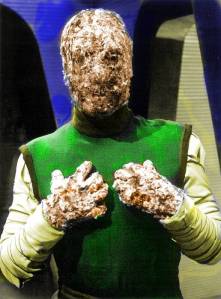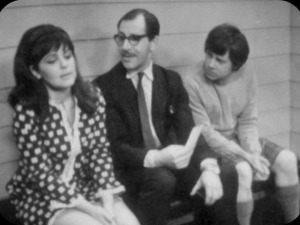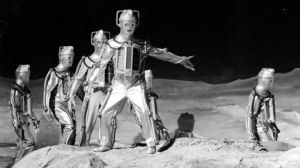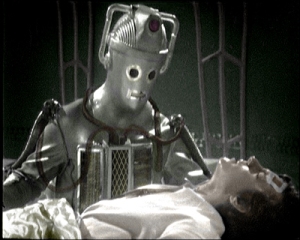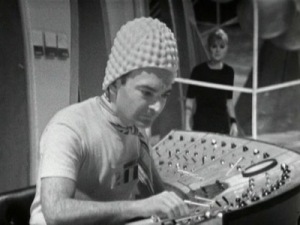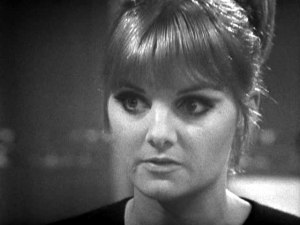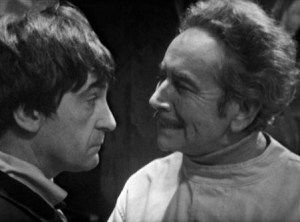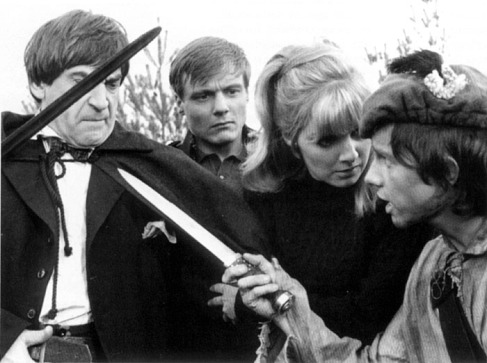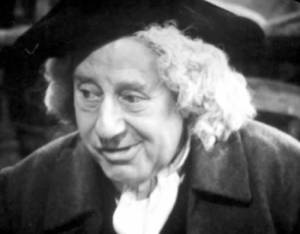If you’d tuned into Doctor Who in March or April 1967 you’d be excused for thinking that the programme’s production team had a real issue with holidaying Brits. Firstly The Macra Terror compared Butlins style Holiday Camps to a colony governed by giant mind-controlling crabs. Then the next serial, The Faceless Ones, took a shot at the bourgeoning package holiday market and groups of 18 to 25 year-olds jetting off from Gatwick Airport to European destinations such as Rome, Dubrovnik and Athens. Participating in such tours could find you miniaturized, shot 150 miles into the air in a aeroplane which transforms into a spaceship, and finally stored away indefinitely in a drawer after an alien has replicated and taken on your form. It’s enough to turn anyone off taking that next holiday!
Mind control and losing one’s identity were issues of great concern to the writers of Doctor Who in the late 1960s. Together with The Macra Terror and The Faceless Ones, such themes were also addressed in a number of other stories. In the Cybermen serials there was the ever present threat of being upgraded and becoming one of them. In the Underwater Menace you were at risk of being turned into a Fish Person, and miniaturization and long time storage had been canvassed in The Ark.
The Faceless One marks the real beginning of the classic pairing of Jamie and the Second Doctor. In his previous outings in the Tardis Jamie had been almost a tacked on afterthought. Written hastily into the series after his first appearance in The Highlanders, Jamie paraded around in a black wet suit in The Underwater Menace, moaned in a half conscious state about the “Phantom Piper” in The Moonbase, and showed his resilience to mind washing in The Macra Terror. Jamie’s amazement at the technology of the 20th Century is at last played upon in this serial. Large passenger aircraft are “flying beasties”, £28 is a fortune and Gatwick Airport is a world unlike any that he’s ever seen. The audience is left wondering if the Highlander from 1746 is literate as he hides behind The Times newspaper which he holds upside down. They must also wonder what sort of fools the people searching for Jamie are, that they don’t notice the hairy legs of a kilted lad beneath the paper.
It is not until this outing that Jamie is paired principally with the Doctor, although he does spend a fair amount of air time with the Liver Bird, Samantha Briggs. The Liverpudlian character, whose brother was lost on one of the Chameleon Tours, was played by Pauline Collins and would have become the new companion had Collins agreed to the offer. I have little doubt that there were no regrets as her career progressed to stellar heights. Collins was not to appear in Doctor Who again until the 2006 Series 2 story, Tooth and Claw, in which she played Queen Victoria.

Pauline Collins played a girl from Liverpool, Samantha Briggs, who was searching for her lost brother

Pauline Collins’ next appearance in Doctor Who would be 39 years later as Queen Victoria in Tooth and Claw
Jamie’s rapport with the Doctor is incredible but is only the beginning of a steadfast relationship which will mature during Seasons five and six. This partnership, however, is at the expense of Ben and Polly who depart the Tardis Crew at the end of episode six. Ben’s days were numbered from Jamie’s arrival in The Highlanders and it was unfortunate that the dynamic between the two modern day London companions was lost. Anneke Wills chose to relinquish her role as Polly once Michael Craze’s departure became known.
Ben and Polly’s farewell was not much better than Dodo’s in The War Machines, which was incidentally Ben and Polly’s first adventure with the Doctor. Absent from episodes three, four and five, they only appeared in a pre-filmed segment at episode six’s close. A ten month companionship spanning two Doctors ended abruptly when the couple realized that it was 20 July 1966, the very day that they’d stumbled into the Tardis at the conclusion of The War Machines. Although visibly upset, Polly was pleased to be able to get back to her own world. The Doctor said how lucky they were because he never got to return to his. Exhibiting a marked sexism the Doctor stated, “Now go on, Ben can catch his ship and become an Admiral, and you Polly, you can look after Ben”. What a life. You could tell it was 1967! After Polly enquired as to whether the Doctor would be safe, Jamie assured her that “I’ll look after him”.
The Second Doctor’s first present day serial, The Faceless Ones, is sure to have influenced Mark Gatiss when he wrote the Series 2 story The Idiot’s Lantern. In that 2006 Tenth Doctor story an evil entity, The Wire, existed only in the form of energy. She transferred herself between television sets and fed off humanity’s mental signals as people innocently watched the telly. In stealing the humans’ energy The Wire hoped to one day regain a corporeal form. Her victims, however, were robbed of their faces and minds, although they still retained consciousness. Faceless the victims became, but nowhere near as grotesque as their predecessors in The Faceless Ones.
Overall, I thoroughly enjoyed The Faceless Ones and am saddened that only two of the six episodes are held in the BBC Archives. The Second Doctor serials are just such a delight and it’s appalling that there are only a handful of complete Troughton serials remaining. As the Doctor and Jamie walked off at the story’s end, looking for the stolen Tardis, I contemplated how pleased I was that Doctor Who is a British and not an Australian programme. Jamie would never have had his Scottish accent stolen, and replaced by a Received Pronunciation one in the Chameleon-Jamie, if the show was made in Australia. Nor would the actor who played the Police Inspector Crossland experience such difficulties in gaining and retaining a Scots brogue. Most importantly, however, the humans who were replicated by the Chameleons would never have been left hidden in cars. Residing in such a hot environment we’re all too schooled in the “dogs die in hot cars” commercials to ever contemplate leaving a human in one! Join me next time as Season four comes to an end with The Evil of the Daleks and Doctor Who gets its newest companion, Victoria.

The Faceless Ones was originally broadcast in the UK between 8 April and 13 May 1967. Episodes 1 and 3 are available on the triple DVD set Lost in Time
Vivien Fleming
©Vivien Fleming, 2013.









